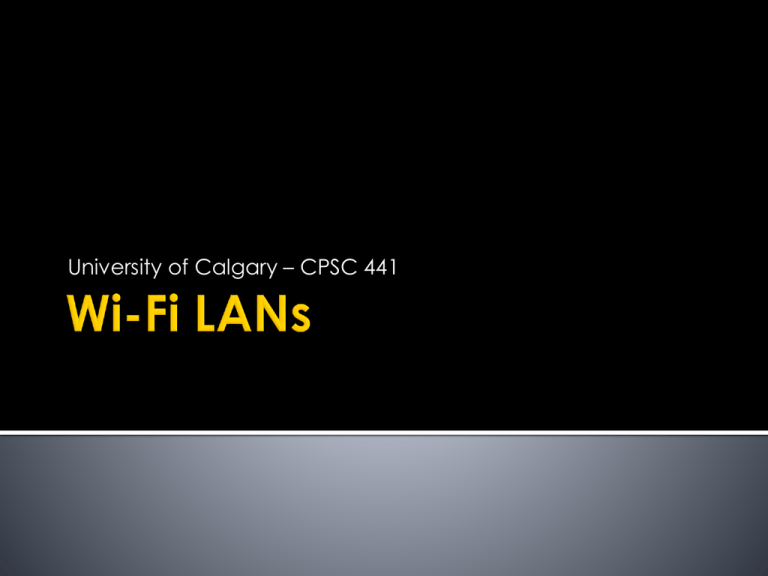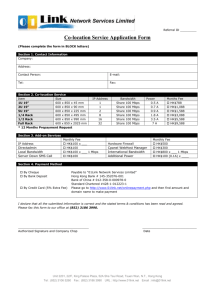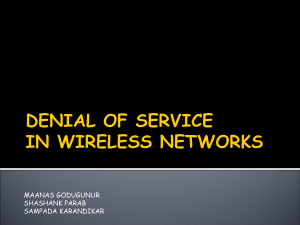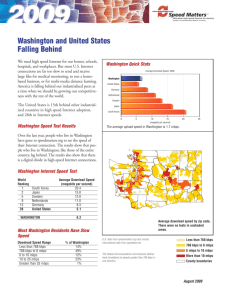Document
advertisement

University of Calgary – CPSC 441 Wi-Fi or WiFi: defined as any "wireless local area network (WLAN) products that are based on the IEEE 802.11 standards. Popular technology that allows an electronic device to exchange data wirelessly (using radio waves) over a computer network. IEEE established the 802.11 Group in 1990. Specifications for standard ratified in 1997. Initial speeds were 1 and 2 Mbps. IEEE modified the standard in 1999 to include 802.11a (54 Mbps) and 802.11b (11 Mbps). Incidentally, 802.11b equipment was available before 802.11a. 802.11g (54 Mbps) was added in 2003. 2 In many respects, the IEEE 802.11b wireless LAN (WLAN) standard is similar to that of classic IEEE 802.3 (Ethernet) LANs Similarities: LAN with limited geographic coverage Multiple stations, with 48-bit MAC addresses Shared transmission medium (broadcast technology) CSMA-based Medium Access Control protocol Comparable data rates (11 Mbps vs 10 Mbps) 3 But there are also many distinct differences: Wireless (air interface) versus wired (coax) Wireless propagation environment (multipath) Higher error rate due to interference, fading, etc. Successful frames are ACKed by receiver Mobile stations versus fixed stations Half-duplex versus full-duplex operation “Hidden node” and “exposed node” problems (exposed node problem occurs when a node is prevented from sending packets to other nodes due to a neighboring transmitter.) Potential asymmetries of links CSMA/CA versus CSMA/CD Multiple data transmission rates (1, 2, 5.5, 11) 4 Infrastructure mode vs “ad hoc” mode: Devices in a wireless network are set up to either communicate indirectly through a central place — an access point — or directly, one to the other. Access Point (AP) sends “beacon frames” – all the information about the network (e.g. Timestamp Capability information) Mobiles choose AP based on signal strength Multiple channel access protocols supported CSMA/CA (DCF – Distributed coordination function); PCF (Point Coordination Function); RTS/CTS (Request to Send/Clear to Send) 5 MAC-layer can provide error control, retransmission, rate adaptation, etc. Direct Sequence Spread Spectrum (DSSS) Modulation technique Signal spread across 22 MHz with each channel based around a center frequency. There are fourteen 22-MHz channels. 6 ISM (Industrial, Scientific, Medical) Band 902-928 MHz 2.4 – 2.5 GHz 5.725 – 5.875 GHz 802.11-1997 802.11b/g/n 802.11a/n/ac Cordless Phones Cordless Phones Baby Monitors Baby Monitors 24 – 24.250 GHz 57 – 66 GHz 802.11ad Amateur Satellite Bluetooth Microwave Ovens 7 Applicatio n Telnet, FTP, Email, Web Transport TCP, UDP, SCTP Network IPv4, IPv6 Data Link 802.3 (Ethernet) MAC, 802.11 (Wi-Fi) MAC, DOCSIS, ISDN Physical Copper LAN: 10/100/1000/10G/40GBASET Fiber LAN: 10GBASE-SR/LR/ER Wireless LAN: FHSS, DSSS, IR Wi-Fi occupies layers 1 & 2 only! 8 Access Point coverage area is called a “Cell” 11 Mbps bandwidth “shared” by all devices in the Cell! Access Point Channel 6 ESSID: NAI Range per Access Point is 100m In Canada/US, there are eleven 802.11b/g channels Only channels 1, 6 and 11 are non-overlapping Computers can roam between cells 9 1 1 11 6 11 1 10 Carrier Sense Multiple Access with Collision Avoidance (CSMA-CA) Device wanting to transmit senses the medium (air) If medium is busy, it defers If medium is free for certain period (DIFS – Distributed Inter-Frame Space), it transmits frame DIFS is approximately 128 µs Latency can increase if “air” is very busy since devices will have a hard time finding “open air” to send frames! 11 send frame DIFS data SIFS Receive ACK back that frame was received intact! ack others NAV: defer access “Air” is free for DIFS time period source destination All other devices must defer while “air” is busy DIFS – Distributed Inter-Frame Space (approx. 128 µs) SIFS – Short Inter-Frame Space (approx. 28 µs) Every frame is ACKed except broadcast/multicast 12 If no ACK received “right away”, then the sender retransmits the frame again at the MAC layer indicates frame (or ACK) was lost/corrupted very short timeout (e.g., 1 ms) exponential back off (doubling) if repeated loss Typically recovers before TCP would notice Max retransmission limit (e.g., 8) May do MAC-layer rate adaptation or frame fragmentation if channel error rate is high 13 Point Coordination Function (PCF) AP polls stations in turn to see if there’s frames to send useful for real-time traffic Request-To-Send/Clear-To-Send (RTS/CTS) reservation-based approach (ask permission) useful for very large frames useful for solving the “hidden node” problem (when a node is visible from a wireless access point (AP), but not from other nodes) request asks for clearance (permission) to send request also indicates time required for transmit 14 Two frame formats available: long preamble short preamble Configuration option for NIC (Network interface controller) and AP Variable-size frames (maximum of 2312 bytes for payload) 16-bit Cyclic Redundancy Code (CRC) for error checking of frames 15 Long Preamble = 144 bits Interoperable with older 802.11 devices Entire Preamble and 48 bit PLCP (Physical Layer Convergence Protocol) header sent at 1 Mbps Transmitted at 1 Mbps Signal 128 bit Preamble (Long) 16 bit Speed Service Start 1,2,5.5, (unused) Frame 11 Delimiter Length 16 bit of CRC Payload Payload 0-2312 bytes Mbps Transmitted at X Mbps 16 Short Preamble = 72 bits Preamble transmitted at 1 Mbps PLCP (Physical Layer Convergence Protocol) header transmitted at 2 Mbps More efficient than long preamble Transmitted at 2 Mbps Transmitted at 1 Mbps Signal 56 bit Preamble 16 bit Speed Service Start 1,2,5.5, (unused) Frame 11 Delimiter Length 16 bit of CRC Payload Transmitted at X Mbps Payload 0-2312 bytes Mbps 17 Power Management Mobile nodes can “sleep” to save power ▪ Accomplished by using DTIM (Delivery Traffic Indication Message) intervals AP will buffer frames until client requests them AP can use virtual bitmap field in beacons to indicate which stations have data waiting Security Wired Equivalent Privacy (WEP) ▪ Not very secure at all! To address this weakness, there is WPA2 (IEEE 802.11i) ▪ Uses CCMP, an AES-based encryption mode with strong security 18



